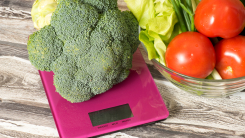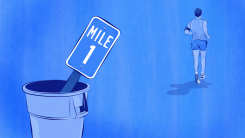The Good and the Bad of the 800-Gram Fruit and Vegetable Challenge

Diet “challenges” are, by their nature, strict and not sustainable. (That’s what makes them challenges.) They usually demand you restrict your food choices in some way, such as cutting out entire food groups. But what if there was a diet challenge that just wanted you to eat more vegetables? That’s the idea behind the 800-gram challenge.
What is the 800-gram challenge?
The basic idea is simple: You eat 800 grams of fruits and/or vegetables each day. That’s it, that’s the challenge.
Surely it can’t be that simple! you might object. Well, you’re right. There is an official website for the challenge, and if you sign up for the newsletter, you’ll get a free guide telling you the rules for the challenge. This includes a big list of “Yes they count!” foods and a smaller list of “No, they don’t count” foods. (You can also view those lists at the main website.) Corn and potatoes count. Raisins, juices, and nuts do not.
It also includes a note that the hashtag #800gChallenge is trademarked, and “cannot be used for organized programs, challenges, or coaching without licensing from OptimizeMe nutrition.”
Why 800 grams?
The 800-gram challenge website cites a 2017 meta-analysis on fruit and vegetable consumption. The authors concluded that the more fruits and vegetables you eat, the lower your risk of cancer, cardiovascular disease, and “all-cause mortality” (which makes it sound like if you eat enough vegetables you’ll live forever, but they just mean you’ll live longer). The benefits level off at 600 grams per day for cancer risk, and 800 grams per day for everything else. If you eat more, that isn’t a bad thing, it just isn’t necessarily any better than eating 800 grams.
They write: “An estimated 5.6 and 7.8 million premature deaths worldwide in 2013 may be attributable to a fruit and vegetable intake below 500 and 800 g/day, respectively, if the observed associations are causal.” That is, I will note, a big if.
Despite what a few contrarians on TikTok want you to believe, fruits and vegetables are associated with good health—in this study and in others. Will you personally avert death by eating 800 grams of fruits and veggies? Nobody can guarantee that. But it isn’t likely to hurt.
Need a food scale?
-
This Ultrean scale is only $10 and will get the job done just fine (I own a similar model).
-
This two-platform KitchenAid scale ($40) is what my cheap scale wishes it could be.
-
This mechanical kitchen scale ($37.50) will have you feeling like you live in an old-timey grocery store.
How much fruit and vegetables does it take to hit 800 grams?
I had to try the challenge, of course. The prescribed 800 grams sounded like it would be a lot, since that’s 28 ounces, or about 1.75 pounds. Per day.
The OptimizeMe website helpfully offers that this amount of fruits and veggies is about six cups, typically totals 400 to 500 calories, and can fit on a dinner plate. You would split that up over your full day of eating, of course—so about two cups per meal. And it’s up to you how much of that you want to be fruit and how much will be vegetables.
Here’s what I ate on the first day of the challenge:
-
Banana, 199 g
-
Two small apples, 215 g
-
Carrot, 80 g
-
Black bean soup, ingredients 381 g (beans, onions, etc.—I weighed these as I made the recipe and then divided the total by the number of servings)
-
Total for the day: 875 g
In addition, I had a slice of pizza, some Sour Patch candy, a package of pork bao from Trader Joe’s, a leftover Olive Garden breadstick, a small portion of steak, and an Old Fashioned cocktail. Total: 2,580 calories, which is neither unusually high nor low for me.
I did have to work to get those veggies in. The soup was a meal I had already planned for the day, and I might normally have an apple or a banana at some point, but on this particular day I had two apples, one banana, and one carrot as snacks. It took extra effort, but not enough to be onerous.
I kept up the challenge for over a week, with totals of 875, 804, 830, 838, 877, 777, 745, 765, and 756 grams. You can see I stopped worrying so much about meeting the magic number of 800. I also got a bit lazy about weighing: Bananas usually came out to around 200 grams, so instead of weighing a banana, I would just log it as 200. There’s an asterisk on those banana numbers, though, which we’ll get to.
How realistic is the 800-gram challenge?
Based on my experience—as a person who routinely buys fruits and veggies, preps meals on the weekend, and has a decently large calorie budget to work with—it wasn’t hard at all to do for a week. It was getting old by the end of the week, though. Here are a few things you should consider if you want to give this challenge a try:
Weighing isn’t hard, but the way they want you to weigh things is annoying
I’m no stranger to the food scale, but come on, do I really have to weigh the onion that I’m about to chop to make some soup? If I’m following the challenge, I do. And then I have to jot it down on a piece of paper somewhere, because this isn’t something that apps do automatically (unlike calories, where I can scan the barcode on that pack of Trader Joe’s bao and have the data saved instantly to my phone).
Another thing that annoyed me: I don’t think you’re supposed to count the peel on the banana, or the core of the apple. My 200-gram bananas were likely only supposed to count as 120 grams or so. But who is going to weigh their banana peel when they’re done? Or their apple core? The beauty of an apple as a snack is that you can eat it on the go. I’m not saving the core to weigh when I get back home.
The rules don’t always make sense
And another thing! The rules of the challenge are arbitrary and—yep, I’m going to say it—stupid. Hummus only counts if you make it yourself, not if you buy it. (Sorry, I counted my store-bought hummus.) Applesauce and pickles don’t count if there’s any sugar in them—what? Like the sugar somehow cancels out the fact that applesauce is made of apples?
You could defend these rules by saying you want to make sure that the 800 grams only counts fruits and vegetables, not oil that might be added to the hummus or sugar that is added to the applesauce. But does that really justify not counting those items? It sounds more like an opportunity to restrict foods or to make foods less accessible. How many of us make our own hummus?
The rule about juice had the same feel to it, too. Juice counted as fruit in at least some of the studies that the meta-analysis was based on. Striking it from the list for an internet challenge sounds like an attempt to make the challenge fit with other rules beyond just meeting a total. I’m not a huge fan of juice, nutritionally speaking, but it seems unfair to add an anti-juice rule. Even myplate.gov allows juice in your daily servings of fruit (they just recommend that you don’t allow it to be all your daily fruit, and cap it at half).
Going from 0 to 800 grams may make your tummy unhappy
This isn’t an issue I had, but one I see reported a lot: Not everybody’s gut is ready to handle that amount of fiber all at once. It’s an 800-gram challenge that people tend to jump into all at once, not a “slowly work up to eating 800 grams every day” plan. Your intestines might prefer the latter.
You may be tempted to turn it into a weightloss diet
The challenge’s website asks if you are “sick of the lack of results” from restrictive diets, which seems to imply that this challenge is a pathway to “results” that you have not heretofore gotten. Sure sounds like they’re talking about weight loss. PopSugar, in writing about the challenge, presents it as a “simple solution” for “trying to lose weight.”
There seems to be a temptation to think of eating more vegetables as another way to say “eating fewer calories.” We’ve seen this in “healthy eating” talk in general (see my rant about how healthy eating is not the same thing as dieting). Fruits and veggies are great, but you also need protein, healthy fats, and other nutrients they don’t provide. If you’re chasing the 800 gram number, and allowing that to displace other foods on a low calorie diet, you may not be eating very “healthy” after all.
Every time somebody says “800 grams by weight,” I want to scream
Finally, if you’ll allow me one pedantic quibble, the website and many of the people who talk about the #800gChallenge talk about getting 800 grams “by weight” of fruits and veggies. Unlike ounces, which come in both a measure of weight (“ounces”) and a measure of volume (“fluid ounces”), grams only work one way. And technically they are a measure of mass, not weight, but that’s a physics lesson for another time.
Final thoughts on the 800-gram challenge
I feel conflicted about this whole thing. On the one hand, getting more fruits and veggies is a good thing, and I like that the challenge has you focus on what you are including in your diet, rather than encouraging you to cut things out. It also gives you credit for what you already eat, rather than demanding you add a certain amount; if you already eat 600 grams of fruit and veggies most days, you only need to add another 200.
I also like that the focus isn’t on body size, but on healthy eating. Even if you ignore the formalized challenge and just take the results of the fruit-and-vegetable research to heart, you’re eating veggies to make yourself healthier, not to lose weight. Not everybody needs to lose weight, but we can all benefit from working a variety of plant foods into our diet.
Ultimate I think my biggest problem with the challenge is the challenge format. The OptimizeMe website promises an “antidote to dieting nonsense” and then tells you to weigh your food and consult yes/no lists. That sounds like dieting nonsense to me.
But then again: If somebody told you it’s good to get 800 grams of vegetables, you’d probably agree and then ignore them. If your whole Crossfit gym is doing a “challenge” together for a limited time, you now have a structure encouraging you to see how much plant matter you’re actually eating, and take the recommendation seriously. Maybe the human brain needs silly challenges to thrive.



